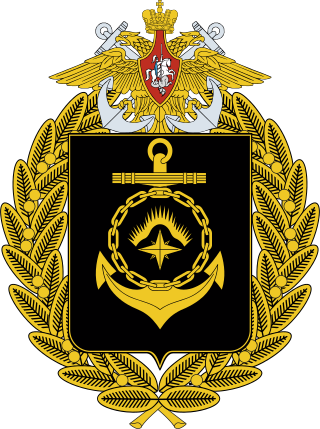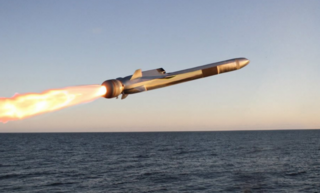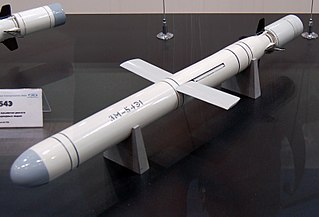Related Research Articles

The Russian Navy is the naval arm of the Russian Armed Forces. It has existed in various forms since 1696; its present iteration was formed in January 1992 when it succeeded the Navy of the Commonwealth of Independent States.

The Northern Fleet is the fleet of the Russian Navy in the Arctic.

The Black Sea Fleet is the fleet of the Russian Navy in the Black Sea, the Sea of Azov and the Mediterranean Sea. The Black Sea Fleet, along with other Russian ground and air forces on the Crimean Peninsula, are subordinate to the Southern Military District of the Russian Armed Forces. The fleet traces its history to its founding by Prince Potemkin on 13 May 1783 as part of the Imperial Russian Navy. The Russian SFSR inherited the fleet in 1918; with the founding of the Soviet Union in 1922, it became part of the Soviet Navy. Following the collapse of the Soviet Union in 1991, the Black Sea Fleet was partitioned between the Russian Federation and Ukraine in 1997, with Russia receiving title to 82% of the vessels.

The Baltic Fleet is the fleet of the Russian Navy in the Baltic Sea.

The Naval Strike Missile (NSM) is an anti-ship and land-attack missile developed by the Norwegian company Kongsberg Defence & Aerospace (KDA).

The Udaloy class, Soviet designation Project 1155 Fregat and Russian designation Project 11551 Fregat-M, are series of anti-submarine guided-missile destroyers built for the Soviet Navy, seven of which are currently in service with the Russian Navy. Twelve ships were built between 1980 and 1990, while the thirteenth ship built to a modified design, known as Udaloy II class, followed in 1999. They complement the Sovremenny-class destroyers in anti-aircraft and anti-surface warfare operations. The codename Udaloy comes from an archaic Russian adjective удалой, meaning daring or bold.

The P-800 Oniks, marketed in export as the Yakhont, is a Soviet / Russian supersonic anti-ship cruise missile developed by NPO Mashinostroyeniya as a ramjet version of P-80 Zubr. Its GRAU designation is 3M55, the air launched Kh-61 variant was planned but never built. The missile has the NATO codename SS-N-26 "Strobile". Development commenced in 1983, and in the 1990s the anti-ship missile was tested on the Project 1234.7 ship. In 2002 the missile passed the whole range of trials and was commissioned. It is reportedly a replacement for the P-270 Moskit, and possibly also of the P-700 Granit.

The Steregushchiy class, Russian designation Project 20380, is a class of corvettes being built for the Russian Navy. Designed by the Almaz Central Marine Design Bureau, subsequent vessels were built to an improved design, incorporating the Zaslon-Redut SAM system. The ship full displacement and dimensions are large for a corvette, thus it is designated as a frigate by NATO. The Steregushchiy class has been further developed into the Gremyashchiy class and Project 20386 subclasses. The export variant is known as Project 20382 Tigr.

The Novator Kalibr, also referred to as 3M54-1 Kalibr, 3M14 Biryuza, is a family of Russian cruise missiles developed by NPO Novator (OKB-8). It first saw service in 1994. There are ship-launched, submarine-launched and air-launched versions of the missile, and variants for anti-ship, anti-submarine and land attack use. Some versions have a second propulsion stage that initiates a supersonic sprint in the terminal approach to the target, reducing the time that air defense systems have to react, while subsonic versions have greater range than the supersonic variants. The missile can carry a warhead weighing up to 500 kilograms (1,100 lb) of explosive or a thermonuclear warhead.

Russian cruiser Varyag, formerly Chervona Ukraina, is the third ship of the Slava-class of guided missile cruisers built for the Soviet Navy now serving the Russian Navy.

The Buyan class, Russian designations Project 21630 Buyan and Project 21631 Buyan-M, are series of corvettes developed by Zelenodolsk Design Bureau for the Russian Navy. Since 2010, all subsequent vessels are being constructed as improved Project 21631 subclass, incorporating greater tonnage, stealth technology and the 3S14 vertical launching system for either Kalibr or Oniks anti-ship cruise missiles, significantly enhancing combat capabilities. The ships are primarily designed for operations within littoral zones to protect Russia's vast coastal areas. Due to the small tonnage, they can operate even within shallow parts of oceans and seas and Russia's extensive inland waterway system. The export variant is known as Project 21632 Tornado.

Marshal Shaposhnikov is a modernized Udaloy-class destroyer of the Russian Navy commissioned in 1985. The vessel serves in the Russian Pacific Fleet. Her namesake is Marshal Boris Shaposhnikov.

Admiral Flota Sovetskogo Soyuza Gorshkov is an Admiral Gorshkov class frigate of the Russian Navy and the lead ship of the class.

The Pacific Fleet is the Russian Navy fleet in the Pacific Ocean. Established in 1731 as part of the Imperial Russian Navy, the fleet was known as the Okhotsk Military Flotilla (1731–1856) and Siberian Military Flotilla (1856–1918), formed to defend Russian interests in the Russian Far East region along the Pacific coast. In 1918 the fleet was inherited by the Russian Soviet Federative Socialist Republic, then the Soviet Union in 1922 as part of the Soviet Navy, being reformed several times before being disbanded in 1926. In 1932 it was re-established as the Pacific Fleet, and was known as the Red Banner Pacific Fleet after World War II as it had earned the Order of the Red Banner. In the Soviet years, the fleet was also responsible for the Soviet Navy's operations in the Indian Ocean and Arabian Sea. Following the collapse of the Soviet Union in 1991, the Red Banner Pacific Fleet was inherited by the Russian Federation as part of the Russian Navy and its current name was adopted.

The Gremyashchiy class, Russian designation Project 20385, is an update of the Steregushchiy-class corvettes of the Russian Navy at a cost of 150 million $. This follow-on project was designed by the Almaz Central Marine Design Bureau in Saint Petersburg. The first ship was laid down on 26 May 2011 and the official laying down ceremony took place on 1 February 2012. Although classified as corvettes by the Russian Navy, these ships carry sensors and weapon systems akin to frigates and, as a result, are so classified by NATO.
Following the dissolution of the Soviet Union at the end of 1991, the Russian Navy struggled to adjust Cold War force structures while suffering severely with insufficient maintenance and a lack of funding. However, there were improvements in the Russian economy over the first decade of the twenty-first century. The economy and standard of living grew rapidly during the early period of Putin's regime, fueled largely by a boom in the oil industry. This led to a significant rise in defence expenditure and an increase in the number of ships under construction.

The Karakurt class, Russian designation Project 22800 Karakurt, is a class of Russian corvettes which have been entering service with the Russian Navy since 2018.
The 3M22 Zircon, also spelled as Tsirkon is a Russian scramjet-powered, nuclear-capable hypersonic cruise missile. Produced by NPO Mashinostroyeniya for the Russian Navy, the missile utilizes the ZS-14 launch platforms on frigates and submarines. The missile has a reported top speed of Mach 9. The weapon was first used during Russia's invasion of Ukraine.

Stoikiy is a Steregushchiy-class corvette of the Russian Navy.
References
- ↑ "Russia approves Otvet for naval duties". Shephard Press Limited. 19 January 2022.
- ↑ "Russia Completes Trials Of New Otvet Anti-Submarine Missile". Naval News. TASS. 30 December 2020.
- ↑ "Russian corvette Gremyashchy launches Otvet missile in Sea of Japan". Navy Recognition. 6 May 2022.
- ↑ "Russia's Otvet anti-submarine missile successfully hits target in Sea of Japan". TASS. 15 December 2021.